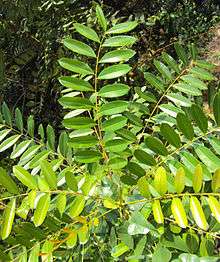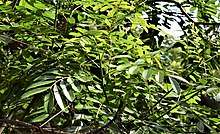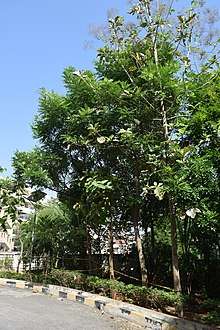Simarouba glauca
Simarouba glauca is a species of flowering tree that is native to Florida, South America, and the Caribbean. Common names include paradise-tree, dysentery-bark, bitterwood and Lakshmi Taru.[2] Its seeds produce an edible oil. The tree is well suited for warm, humid, tropical regions. Its cultivation depends on rainfall distribution, water holding capacity of the soil and sub-soil moisture. It is suited for temperature range of 10 to 40 °C (50 to 104 °F). It can grow at elevations from sea level to 1,000 m (3,300 ft). It grows 40 to 50 ft (12 to 15 m) tall and has a span of 25 to 30 ft (7.6 to 9.1 m). It bears yellow flowers and oval elongated purple colored fleshy fruits.
| Simarouba glauca | |
|---|---|
 | |
| Scientific classification | |
| Kingdom: | Plantae |
| Clade: | Tracheophytes |
| Clade: | Angiosperms |
| Clade: | Eudicots |
| Clade: | Rosids |
| Order: | Sapindales |
| Family: | Simaroubaceae |
| Genus: | Simarouba |
| Species: | S. glauca |
| Binomial name | |
| Simarouba glauca | |
Cultivation
It can be propagated from seeds, grafting and tissue culture technology. Fruits are collected in the month of April / May, when they are ripe and then dried in sun for about a week. Skin is separated and seeds are grown in plastic bags to produce saplings. Saplings 2 to 3 months old can be transplanted to a plantation.


Use
The wood is generally insect resistant and is used in the preparation of quality furniture, toys, matches, as pulp (in paper making). It can be also used for industrial purposes in the manufacture of biofuel, soaps, detergents, lubricants, varnishes, cosmetics, and pharmaceuticals.[3] Though there is some research [4] claiming that Simarouba is effective for treating certain diseases, there seems to be insufficient evidence[5] of curing diarrhea, malaria, edema, fever and stomach upset. Simarouba glauca, is known as Lakshmi Taru in India, and the extracts from parts of the tree, despite having potent anticancer properties, to date, no systematic research, using phytochemicals isolated from Simarouba Glauca, has been carried out to explore the molecular mechanisms leading to cancer cell death.[6] Simarouba extracts are known to be effective only on specific types of human cancer cell lines and tests conducted were invitro. Whether the same effect would be observed under invivo conditions, depends on bioavailability and bioaccessibility,[7] hence Simarouba as an alternative cure for cancer remains unproven.There are people who claim to cure cancer using this but its simply not true. sratsti traders a company sells this medicine(in amazon) as a cure for cancer is proven completely a hox, there is an ongoing legal battle against that.
Environmental impact
The tree forms a well-developed root system and dense evergreen canopy that efficiently checks soil erosion, supports soil microbial life, and improves groundwater position. Besides converting solar energy into biochemical energy all round the year, it checks overheating of the soil surface all through the year and particularly during summer. Large-scale planting in wastelands facilitates wasteland reclamation, converts the accumulated atmospheric carbon dioxide into oxygen and contributes to the reduction of greenhouse effect or global warming.
References
- Botanic Gardens Conservation International (BGCI) & IUCN SSC Global Tree Specialist Group (2019). "Simarouba glauca". IUCN Red List of Threatened Species. 2019: e.T150108258A150108260. Retrieved 11 August 2020.
- "Simarouba glauca". Germplasm Resources Information Network (GRIN). Agricultural Research Service (ARS), United States Department of Agriculture (USDA). Retrieved 2009-12-02.
- Lakshmi Taru tree answer to climate change problems: experts
- http://www.rain-tree.com/simaruba.htm. Missing or empty
|title=(help) - https://www.webmd.com/vitamins/ai/ingredientmono-371/simaruba. Missing or empty
|title=(help) - Asha Jose, Elango Kannan, Palur Ramakrishnan Anand Vijaya Kumar, SubbaRao Venkata Madhunapantula (January–December 2019). "Therapeutic Potential of Phytochemicals Isolated from Simarouba glauca for Inhibiting Cancers: A Review". Systematic Reviews in Pharmacy. 10 (1): 73–80. doi:10.5530/srp.2019.1.12. Retrieved 17 January 2020.CS1 maint: multiple names: authors list (link)
- T. G. UMESH (2015). "In-vitro antioxidant potential, free radical scavenging and cytotoxic activity of Simarouba gluaca leaves" (PDF). International Journal of Pharmacy and Pharmaceutical Sciences. 2: 411–6. Retrieved 17 January 2020.
![]()
